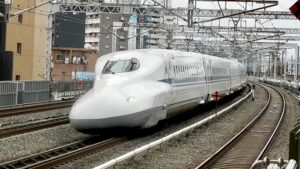
Typhoon Shanshan, also known as Typhoon No. 10, caused widespread disruption across Japan in late August, presenting significant challenges for train operators, including Shinkansen bullet trains, as it moved in unpredictable directions. This year marks a decade since train operators began implementing planned service suspensions to mitigate typhoon impacts, but the execution remains complex.
Central Japan Railway Co. (JR Central) president Shunsuke Niwa highlighted the difficulties in tracking the typhoon's path during a press conference on September 4. The shifting forecasts made it hard to determine when and where to halt services, particularly for the Tokaido Shinkansen. Initially, JR Central and JR West expected landfall between the Kinki and Kanto regions, leading to multiple adjustments to suspension schedules. JR West had announced potential cancellations for the Sanyo Shinkansen services on August 27 and 28, but revised these plans multiple times, finally implementing the suspensions on August 29 and 30, with full cancellations between Hiroshima and Hakata on the latter date. Similarly, JR Central had to alter its Tokaido Shinkansen suspension schedule several times, marking the first time in ten years that services between Tokyo and Shin-Osaka were halted for three days, from August 30 to September 1.
Planned cancellations were first introduced on a large scale in 2014 during Typhoon Vongfong, with JR West suspending services across the Kinki region. JR East followed in 2018, but advance warnings were insufficient, leading to disruptions. In response, the government introduced guidelines requiring operators to notify passengers about potential cancellations 48 hours in advance, with detailed schedules provided 24 hours prior.
JR companies are also working on physical infrastructure improvements to mitigate the impact of extreme weather, such as reinforcing earthen track beds along the Tokaido Shinkansen, which are prone to instability during heavy rain. JR Central aims to strengthen drainage systems to prevent track damage and derailments.
Prof. Makoto Okumura of Tohoku University emphasized that society is becoming more accustomed to planned service cancellations, especially after experiencing travel disruptions during the pandemic. He noted the importance of public understanding that these measures are implemented for passenger safety.